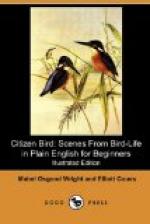“That is the Kingbird,” said the Doctor; “one of the most useful of the insect-catchers. Instead of living on honey-bees, as many people think, he eats very few of these, but kills instead thousands of the bad robber-fly, which is the honey-bee’s worst enemy. This bird is really king of the air and of all fly-catching birds. See how graceful his flight is, and how easily be moves!”
“Why did he go away last fall?” asked Nat. “Does he feel the cold weather very much?
“He does not stay in the United States until the weather is cold enough to dull him; but he has to move away for another reason. The same reason that forces so many birds to leave us—he must follow his food. This food consists of insects—different kinds of flies, ants, and grasshoppers, which disappear or die as the air grows cold.
“Rap, have you ever noticed the difference between the sounds in a spring night and a night in autumn? In spring the air is humming with the calls of all sorts of insects, but in autumn it is silent, and even the crickets have stopped chirping.
“So about the last of September our Kingbirds, who live everywhere in the United States, gather in flocks, start to find a place where insects are still stirring about, and fly southward, following the sea-coast and the great rivers for paths. Those from the eastern part of the country stop in Central America or fly on to South America, and those from the western part often stop in Mexico.”
“But how can they fly so far?” said Nat; “it’s hundreds of miles; and how do they find the way?”
“The flight of a bird is a wonderful thing, my boy. He spreads those frail wings of his, and launches into the air, up, up, above trees and steeples, then on and on, being able to fly several hundred miles without resting. Some birds, when the wind aids them, cover more than a hundred miles in a single hour.
“As to the way, the eye of the bird is like a telescope. It magnifies and sees from very far off. Flying through the upper air the bird watches the line of coast and river, and the instinct that is placed in him says, ‘Follow these.’ So he follows them, remembering that by doing so he has found a place of safety in other seasons. All through the spring and all through the autumn birds take these mysterious flights—for so they always seem to House People, as flock after flock gathers and disappears. You can watch them sometimes passing by day so high in the sky that they seem like dust-motes—then perhaps you will only hear a faint call-note and see nothing. At night the sound of many voices falls from the clouds. Sometimes it will be the tinkling bell of Bobolinks, sometimes the feeble peep of Snipes, and sometimes the hoarse honk of Wild Geese.”
“Why, Uncle Roy! Can you tell a bird’s name without seeing it, only by one little cry?”
“Yes, my lad. When you have lived with birds as long as I have, you will know their different voices as you do those of your own family. When some one calls you in the garden, can’t you tell whether it is Dodo or Olive?”




